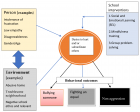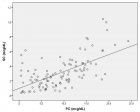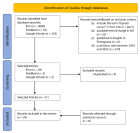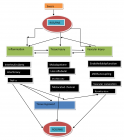Abstract
Review Article
The central role of desire in mediating bullying behavior in schools
Kenneth Rigby*
Published: 26 October, 2022 | Volume 6 - Issue 1 | Pages: 036-039
Numerous studies of bullying in schools have identified aspects of the environment (E) and aspects of the person (P) as contributing to the prevalence of bullying in schools. It is proposed that the concept of desire can play a central role in explaining how bullying in schools arises and how it can be effectively addressed by schools by promoting social and emotional learning, mindfulness, and problem-solving techniques such as the Method of Shared Concern. The article identifies a need for further research to confirm the hypothesized relationships and assess the utility of the concept of desire as a variable in research and the practice of bullying prevention in schools.
Read Full Article HTML DOI: 10.29328/journal.apmh.1001042 Cite this Article Read Full Article PDF
References
- Armitage R. Bullying in children: impact on child health. BMJ Paediatr Open. 2021 Mar 11;5(1):e000939. doi: 10.1136/bmjpo-2020-000939. PMID: 33782656; PMCID: PMC7957129.
- UNESCO (2019) School violence and bullying: global status and trends, drivers and consequences. Paris: UNESCO.
- Ball HA, Arseneault L, Taylor A, Maughan B, Caspi A, Moffitt TE. Genetic and environmental influences on victims, bullies and bully-victims in childhood. J Child Psychol Psychiatry. 2008 Jan;49(1):104-12. doi: 10.1111/j.1469-7610.2007.01821.x. PMID: 18181884.
- Jolliffe D, Farrington D. Examining the relationship between low empathy and bullying. Aggressive Behavior. 2006; 32:540-550.
- Potard C, Pochon R, Henry A, Combes C, Kubiszewski V, Roy A. Relationships between school bullying and frustration intolerance beliefs in adolescence: A gender-specific analysis. Journal of Rational-Emotive & Cognitive-Behavior Therapy. 2021. https://doi.org/10.1007/s10942-021-00402-6
- Astor RA, Benbenisthty R. Bullying School Violence and Climate in Evolving Contexts: Culture, Organization and Time. Oxford: Oxford University Press.
- Bartlett CP, Anderson CA. Direct and indirect relations between the Big 5 personality traits and aggressive and violent behavior. Personality and Individual differences. 2012; 52:8; 870-875.
- Bowes L, Arseneault L, Maughan B, Taylor A, Caspi A, Moffitt TE. School, neighborhood, and family factors are associated with children's bullying involvement: a nationally representative longitudinal study. J Am Acad Child Adolesc Psychiatry. 2009 May;48(5):545-553. doi: 10.1097/CHI.0b013e31819cb017. PMID: 19325496; PMCID: PMC4231780.
- Connell NM, Morris RG, Piquero AR. Predicting Bullying: Exploring the Contributions of Childhood Negative Life Experiences in Predicting Adolescent Bullying Behavior. Int J Offender Ther Comp Criminol. 2016 Jul;60(9):1082-96. doi: 10.1177/0306624X15573760. Epub 2015 Mar 10. PMID: 25759430.
- Modin B, Låftman SB, Östberg V. Teacher Rated School Ethos and Student Reported Bullying-A Multilevel Study of Upper Secondary Schools in Stockholm, Sweden. Int J Environ Res Public Health. 2017 Dec 13;14(12):1565. doi: 10.3390/ijerph14121565. PMID: 29236039; PMCID: PMC5750983.
- Rigby K. (2012) Bullying interventions in schools: Six basic approaches. Boston/Wiley (American edition).
- Anscombe E. Intention (2nd ed). Cambridge: Harvard University Press. 2000.
- Strawson G. Mental reality. Cambridge, MA: MIT Press. 1994.
- Scanlon T. What we owe to each other. Cambridge, MA: Harvard University Press. 1998.
- Geel M, Goemans A, Toprak F, Vedder P. Which personality traits are related to traditional bullying and cyberbullying? A study with the big five, dark triad and sadism. Personality and Individual Differences. 2017; 106(1):231-235
- Pellegrini D, Long JD. A longitudinal study of bullying, dominance, and victimization during the transition from primary school through secondary school. British Journal of Developmental Psychology. 2002; 20:259-280.
- Ajzen I. The theory of planned behavior. Organizational Behavior and Human Decision Processes. 1991; 50(2):179-211.
- Rigby K, Griffiths C. Addressing cases of bullying through the Method of Shared Concern. School Psychology International 32: 345-357.
- Durlak JA, Weissberg RP, Dymnicki AB, Taylor RD, Schellinger KB. The impact of enhancing students' social and emotional learning: a meta-analysis of school-based universal interventions. Child Dev. 2011 Jan-Feb;82(1):405-32. doi: 10.1111/j.1467-8624.2010.01564.x. PMID: 21291449.
- Wigelsworth M, Lendrum A, Oldfield J, Scott A, Ten Bokkel I, Tate K, Emery C. The impact of trial stage, developer involvement and international transferability on universal social and emotional learning programme outcomes: A meta-analysis. Cambridge Journal of Education. 46(3): 347– 376.
- APA org. What Are The Benefits of Mindfulness? 2012. https://www.apa.org/education/ce/mindfulness-benefits.pdf.
- Foody M, Samara M. Considering mindfulness techniques in school-based antibullying programs. Journal of New Approaches in Educational Research. 2018; 7 (1):3-9.
- Liu X, Xiao R, Tang W. The Impact of School-Based Mindfulness Intervention on Bullying Behaviors among Teenagers: Mediating Effect of Self-Control. J Interpers Violence. 2022 Nov;37(21-22):NP20459-NP20481. doi: 10.1177/08862605211052047. Epub 2021 Nov 22. PMID: 34802328.
- Rigby K (2022) Interventions in cases of bullying in schools: a training manual for teachers and counsellors. Melbourne: Hawker-Brownlow.
- Ecclestone K, Hayes D. The Dangerous Rise of Therapeutic Education. London: Routledge. 2009.
- Buckels EE. Multifaceted assessment of sadistic tendencies. In Jonason PK (Ed.). Shining light on the dark side of personality: Measurement properties and theoretical advances. Newburyport MA: Hogrefe. 2022.
- Everitt BS, Dunn G. Applied multivariate data analysis. London: Edward Arnold. 1991.
- Shaw T, Dooley JJ, Cross D, Zubrick SR, Waters S. The Forms of Bullying Scale (FBS): validity and reliability estimates for a measure of bullying victimization and perpetration in adolescence. Psychol Assess. 2013 Dec; 25(4):1045-57. doi: 10.1037/a0032955. Epub 2013 Jun 3. PMID: 23730831.
- Merrin GJ, Espelage DL, Hong JSW. Applying the Social-Ecological Framework to Understand the Associations of Bullying Perpetration among High School Students: A Multilevel Analysis Psychology of Violence. 2018; 8:1; 43-56.
- Campbell DT, Stanley J. Experimental and quasi-experimental designs for research. Chicago, IL: Rand McNally. 1963.
- Farrington D, Ttofi M, Zych I. Protective factors against bullying and cyberbullying: A systematic review of meta-analyses, Aggression and Violent Behavior. 2019; 45:4-19.
- Rigby K. Bullying in Schools: Addressing Desires, Not Only Behaviors. Educational Psychology Review. 2012; 24(2):339-348.
Figures:

Figure 1
Similar Articles
-
Comparison of Cardiovascular Risks following Smoking Cessation Treatments Using Varenicline vs. NRT among Schizophrenic SmokersSusan Abughosh*,I-Hsuan Wu,Hua Chen,Ekere James Essien,Michael Johnson,Patrick Bordnick2,Ronald J Peters. Comparison of Cardiovascular Risks following Smoking Cessation Treatments Using Varenicline vs. NRT among Schizophrenic Smokers. . 2017 doi: 10.29328/journal.apmh.1001001; 1: 001-010
-
Impact of four obesity interventions on biometric measures of individuals positive and negative for food addictionTrina Aguirre*,Leeza Struwe,Ann Koehler,Rebecca Kreman,Rebecca Bowman,Erica Schulte,Kayla Pierce,Molly Bloodgood,effrey Holloway. Impact of four obesity interventions on biometric measures of individuals positive and negative for food addiction. . 2018 doi: 10.29328/journal.apmh.1001002; 2: 001-0005
-
Psychosocial care is necessary in supporting refugeesGudrun Widders*,Ute Teichert. Psychosocial care is necessary in supporting refugees. . 2018 doi: 10.29328/journal.apmh.1001003; 2: 006-008
-
Mental health promotion program in the workplace with focus on transportOlaf Jensen*,Fereshteh Baygi,George Charalambous,Agnes Flores,Lise Hedegaard Laursen,David Lucas,Debbie Andrioti. Mental health promotion program in the workplace with focus on transport. . 2019 doi: 10.29328/journal.apmh.1001004; 3: 001-011
-
Diseases of the mental sphere revealed by the psychiatrist at contingent of patients of the consultative outpatient admissionShapovalova LA*,Shapovalov КA. Diseases of the mental sphere revealed by the psychiatrist at contingent of patients of the consultative outpatient admission. . 2019 doi: 10.29328/journal.apmh.1001005; 3: 012-019
-
Cognition and Memory Impairment among Patients of Depression in Pakistan-The Role of Conventional and Newer Anti-DepressantsMadeeha Malik*,Muhammad Usama Khan,Azhar Hussain,Ayisha Hashmi. Cognition and Memory Impairment among Patients of Depression in Pakistan-The Role of Conventional and Newer Anti-Depressants. . 2019 doi: 10.29328/journal.apmh.1001006; 3: 020-024
-
Effectiveness of ethinyl oestradiol /cyproterone acetate and ethinyl oestradiol/ desogestrel with or without low-dose metformin on perceived health-related quality of life in hirsute women with polycystic ovary disease: A randomised, double-blind, placebo-controlled studySanjeewani Fonseka*,B Subhani,V Alahakoon,CN Wijeyaratne,IB Gawarammana,NS Kalupahana,N Ratnatunga,S Rosairo,PVR Kumarasiri. Effectiveness of ethinyl oestradiol /cyproterone acetate and ethinyl oestradiol/ desogestrel with or without low-dose metformin on perceived health-related quality of life in hirsute women with polycystic ovary disease: A randomised, double-blind, placebo-controlled study. . 2019 doi: 10.29328/journal.apmh.1001007; 3: 025-031
-
A Belgian program to fight child maltreatment: The “SOS children” teamsSophie Dechêne*,Emmanuel de Becker. A Belgian program to fight child maltreatment: The “SOS children” teams. . 2019 doi: 10.29328/journal.apmh.1001008; 3: 032-041
-
Microchimerism may be the cause of psychiatric disordersOsman Demirhan*,Bülent Demirbek. Microchimerism may be the cause of psychiatric disorders. . 2019 doi: 10.29328/journal.apmh.1001009; 3: 042-046
-
Transference and countertransference are linked to placebo-nocebo effects and they are an auxiliary resource of unparalleled value in general medicine: Recommendations for general practitionersJose Luis Turabian*. Transference and countertransference are linked to placebo-nocebo effects and they are an auxiliary resource of unparalleled value in general medicine: Recommendations for general practitioners. . 2020 doi: 10.29328/journal.apmh.1001010; 4: 001-006
Recently Viewed
-
Outpatient operative hysteroscopy: evaluation of patient satisfaction and acceptanceClare Margaret Crowley*,Noelle Gill,Minna Geisler. Outpatient operative hysteroscopy: evaluation of patient satisfaction and acceptance. Clin J Obstet Gynecol. 2022: doi: 10.29328/journal.cjog.1001098; 5: 005-008
-
Predictors of positive treatment response to PTNS in women with overactive bladderSuneetha Rachaneni*,Doyo Enki,Megan Welstand,Thomasin Heggie,Anupreet Dua. Predictors of positive treatment response to PTNS in women with overactive bladder. Clin J Obstet Gynecol. 2022: doi: 10.29328/journal.cjog.1001097; 5: 001-004
-
Prediction of neonatal and maternal index based on development and population indicators: a global ecological studySedigheh Abdollahpour,Hamid Heidarian Miri,Talat Khadivzadeh*. Prediction of neonatal and maternal index based on development and population indicators: a global ecological study. Clin J Obstet Gynecol. 2021: doi: 10.29328/journal.cjog.1001096; 4: 101-105
-
A Genetic study in assisted reproduction and the risk of congenital anomaliesKaparelioti Chrysoula,Koniari Eleni*,Efthymiou Vasiliki,Loutradis Dimitrios,Chrousos George,Fryssira Eleni. A Genetic study in assisted reproduction and the risk of congenital anomalies. Clin J Obstet Gynecol. 2021: doi: 10.29328/journal.cjog.1001095; 4: 096-100
-
Leiomyosarcoma in pregnancy: Incidental finding during routine caesarean sectionToon Wen Tang*,Phoon Wai Leng Jessie. Leiomyosarcoma in pregnancy: Incidental finding during routine caesarean section. Clin J Obstet Gynecol. 2021: doi: 10.29328/journal.cjog.1001094; 4: 092-095
Most Viewed
-
Evaluation of Biostimulants Based on Recovered Protein Hydrolysates from Animal By-products as Plant Growth EnhancersH Pérez-Aguilar*, M Lacruz-Asaro, F Arán-Ais. Evaluation of Biostimulants Based on Recovered Protein Hydrolysates from Animal By-products as Plant Growth Enhancers. J Plant Sci Phytopathol. 2023 doi: 10.29328/journal.jpsp.1001104; 7: 042-047
-
Sinonasal Myxoma Extending into the Orbit in a 4-Year Old: A Case PresentationJulian A Purrinos*, Ramzi Younis. Sinonasal Myxoma Extending into the Orbit in a 4-Year Old: A Case Presentation. Arch Case Rep. 2024 doi: 10.29328/journal.acr.1001099; 8: 075-077
-
Feasibility study of magnetic sensing for detecting single-neuron action potentialsDenis Tonini,Kai Wu,Renata Saha,Jian-Ping Wang*. Feasibility study of magnetic sensing for detecting single-neuron action potentials. Ann Biomed Sci Eng. 2022 doi: 10.29328/journal.abse.1001018; 6: 019-029
-
Pediatric Dysgerminoma: Unveiling a Rare Ovarian TumorFaten Limaiem*, Khalil Saffar, Ahmed Halouani. Pediatric Dysgerminoma: Unveiling a Rare Ovarian Tumor. Arch Case Rep. 2024 doi: 10.29328/journal.acr.1001087; 8: 010-013
-
Physical activity can change the physiological and psychological circumstances during COVID-19 pandemic: A narrative reviewKhashayar Maroufi*. Physical activity can change the physiological and psychological circumstances during COVID-19 pandemic: A narrative review. J Sports Med Ther. 2021 doi: 10.29328/journal.jsmt.1001051; 6: 001-007

HSPI: We're glad you're here. Please click "create a new Query" if you are a new visitor to our website and need further information from us.
If you are already a member of our network and need to keep track of any developments regarding a question you have already submitted, click "take me to my Query."

















































































































































